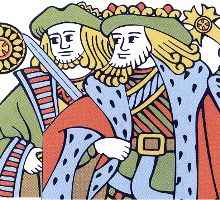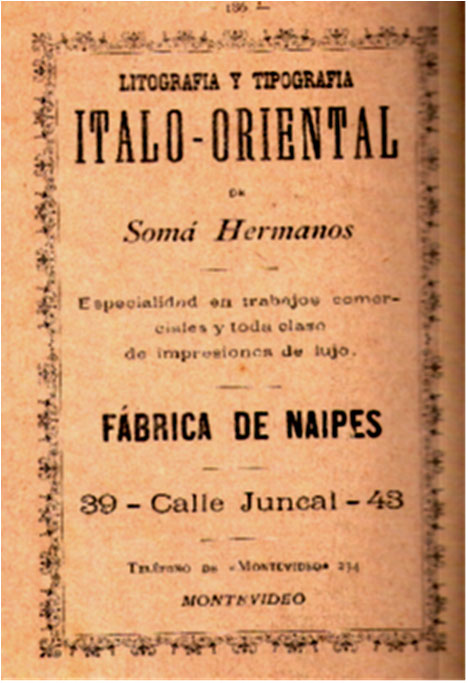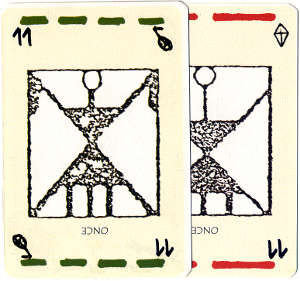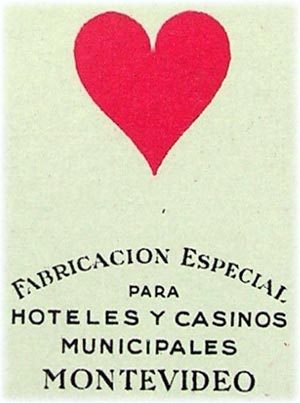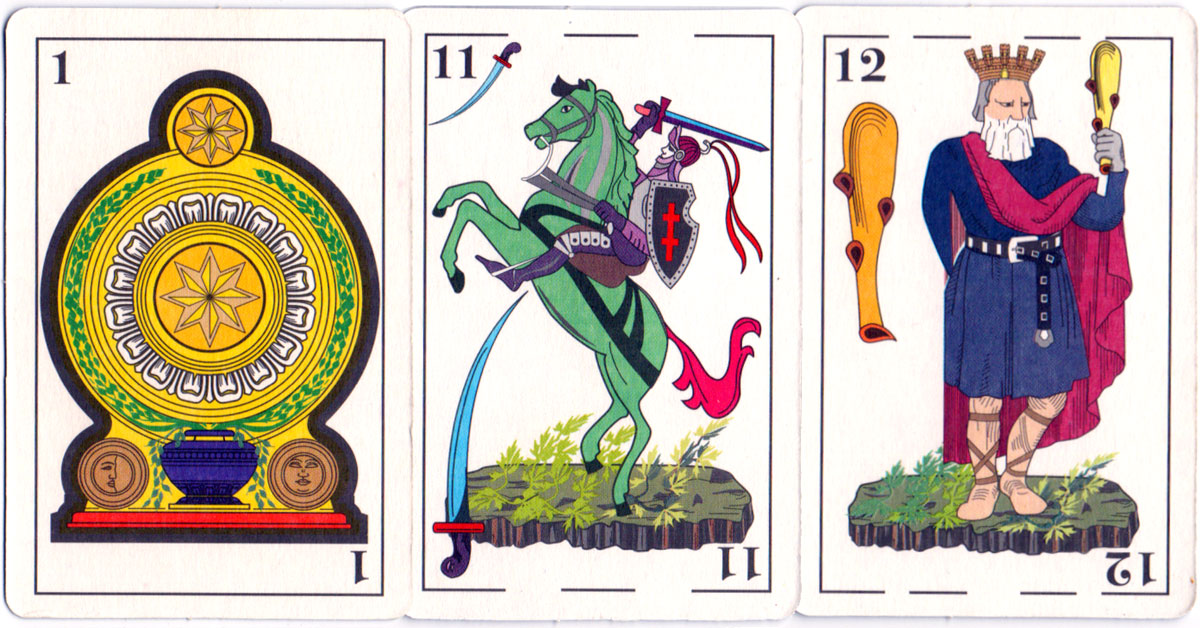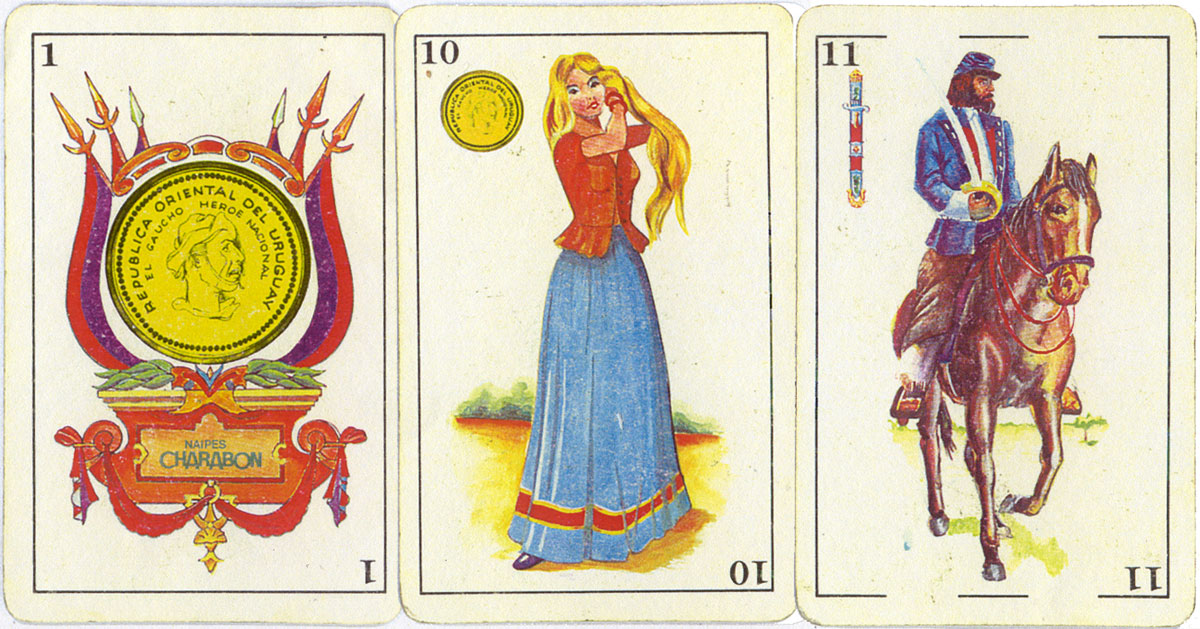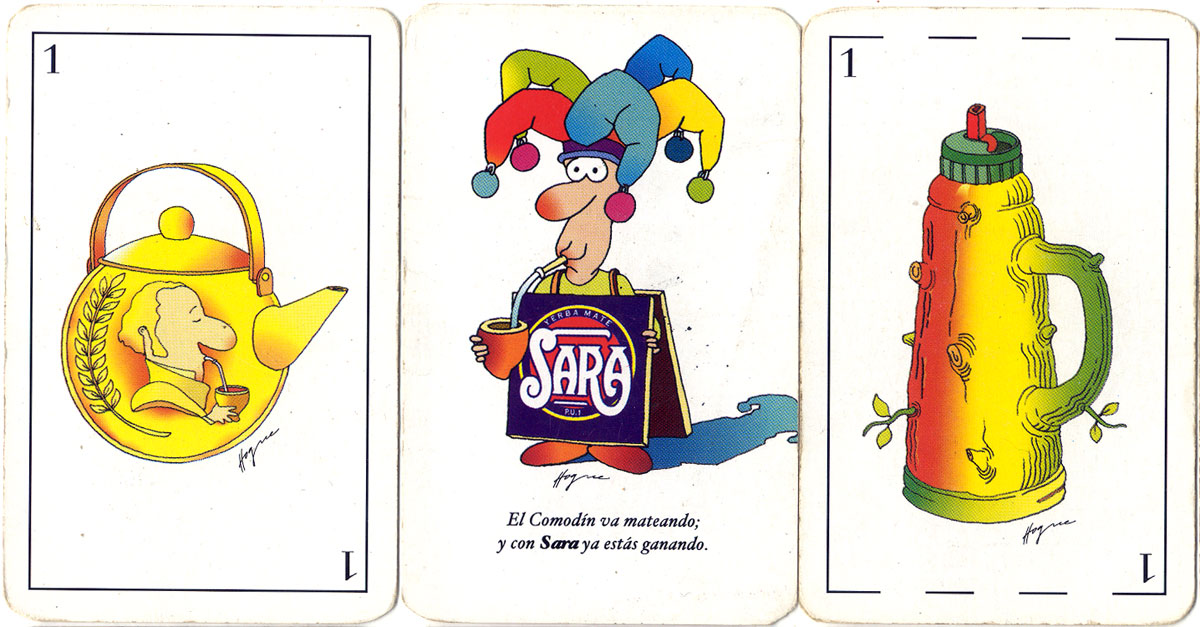Uruguayan Playing Cards
Until the 19th century playing cards were imported into Uruguay from Spain.
Uruguayan Playing Cards - Naipes Uruguayos
Playing Cards in Uruguay employ Spanish suit symbols: cups, swords, coins and clubs (termed copas, espadas, oros and bastos).
Until the 19th century playing cards were imported into Uruguay from Spain. The local population was very fond of card games and the abuse of betting and gambling was often a problem for the authorities. Having introduced playing cards to the region during the 16th century explorations, the Spanish treasury department sought to raise revenues from playing cards and in 1778 a crown monopoly tax was imposed on tobacco and playing cards in the Viceroyship. In return for this, higher quality products were supposed to be made available, although in practice this never happened as the cards supplied from the Real Fábrica de Macharaviaya were always found to be deficient in quality. This royal monopoly finally ended in 1812.
After the abolition of the Estanco de Tabacos y Naipes crates of playing cards were imported from foreign countries such as Belgium, France, Germany, Italy, USA and Spain. In 1850 Sebastián Comas travelled to Argentina and established business relations with importers Fló Hnos in Rosario. With all these imports new patterns and styles of playing cards were introduced, thereby expanding the repertoire of playing card imagery in general use. In 1830 Uruguay was proclaimed an independent republic. The first known local manufacturer was Somá Hnos in 1896, followed by Compañía General de Fósforos Montevideana S.A. in c.1900, and Bartolomé Triay (1906).
Tax applied to playing cards was finally discontinued in 1975.
More related links / ver más...
Known publishers and manufacturers include:
Fray Solano García - Naipes Artiguistas, 1816
Belgian-made pack for Escalada y Vidiella, Montevideo, 1860s
Belgian import for Cerveza el Gallo, Montevideo, 1880s
Somá Hermanos, Litografía y Tipografía Italo-Oriental, Fábrica de Naipes (Montevideo), 1896
Children's playing cards (1920s-30s) - Football,
'National Heroes', Proverbs & Maxims
Botella & Cía, Montevideo, 1920s-30s
José Llorens y Rius 1930s
José Juncosa, Paysandú 1421, Montevideo, 1930s
Camilloni Hnos, Dante 2232, Montevideo - Naipes 'Miguelito',
'Tito'
M.C. de Casabó Ltda, Rondeau 1602, Montevideo - Naipes 'King',
'American', 'Bambú', 'The Monkey', 'Tatú', 'Jaque'
Compañía General de Fósforos Montevideana S.A. - Naipes
'Victoria', 'Victoria Gaucho', 'Ancla', 'Copa de Oro 1980'
Gráficos Unidos S.A. (García Morales-Mercant), Dante 1978, Montevideo
- Naipes 'El Gaucho'
Cervantes, Soriano 873, Montevideo - Naipes 'El Gaucho'
Caraven S.A. - Naipes 'El Gaucho'
Akosol S.A. - Naipes 'Baccarat'
Fantasias S.A., Soriano 813, Montevideo - Naipes 'Retruco'
Ingrapa S.A. (Industria Gráfica y Papelera ? sucesores de C.G.F.M.), Santa Fe 1167 (1980s-90s)
- Naipes '210', Super', 'Ancla', 'Charabon'
Nacadi SRL, Gutierrez Ruiz 1121, Montevideo (c.1999)
Eduardo Carrión, Pablo de María 1057 Ap. 301, 11200 Montevideo (2000- )
Manos del Uruguay (2001) - Las Cartas de Tacuabé
Las Cartas de Sara promotional playing cards for Carrau & Cia, c.2003
Impresos Manrique for: Inacal, Radisson Hotel (Montevideo)
Chocolondo Children's playing cards for Famosa, Paysandu
Anabella Corsi, Montevideo, (2008- ) - Naipes 'La Criolla'
Market conditions are changing in Uruguay. Casabó S.A. have ceased producing playing cards and other more adaptable, new companies are emerging. Corporate publicity packs are currently being produced by Impresos Manrique and Plasur, who source their playing cards from various manufacturers. Packs destined for the Uruguayan market have also been produced anonymously or in neighbouring countries:
Bazar Lusitano, B&N Solari, Mateo Brunet, Carrau y Cia, Libertad S.A., earlier importing wholesalers, c.1900-1950s.
Argenar for Cymaco motor parts
Anonymous (Chinese) for Yerba Armiño
Conrad Punta del Este Casino
Pilsen TrucoFest
Miniature "Naipes Donald" children's playing cards
Miniature playing cards for "Scooby-Doo! Hellmann's Magic"
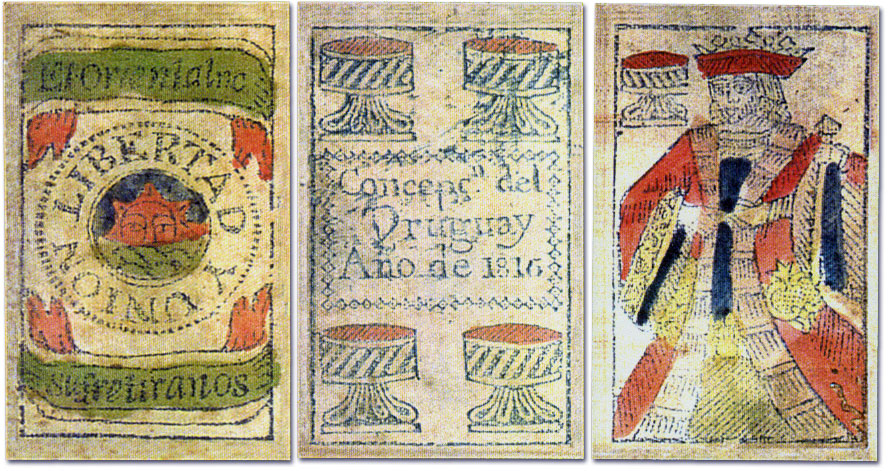
Above: Naipes Artiguistas, Entre Rios (Argentina), 1816, based upon the Spanish 'National' pattern.

Above: Las Cartas de Tacuabé, playing cards made from pieces of hide by Charrúa Indians, modelled on Spanish cards.

Above: Naipes ‘Miguelito’ in the ‘Parisian’ Spanish pattern, manufactured by Camilloni Ltda, Montevideo, c.1950.
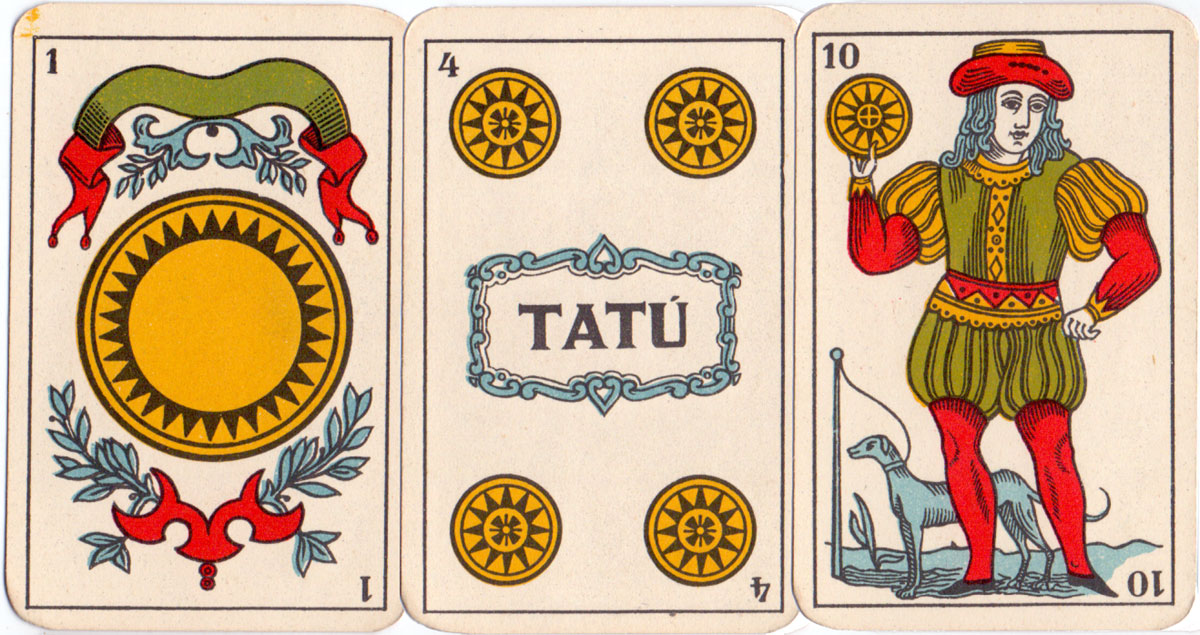
Above: Naipes ‘Tatú’ in the ‘Parisian’ Spanish pattern, manufactured by M.C. de Casabó S.A., Montevideo, c.1956.

Above: Naipes “El Gaucho”, c.1955-60, a re-interpretation of the ‘Parisian’ Spanish pattern.

Above: cards made in Belgium for Escalada y Vidiella, Montevideo c.1860.
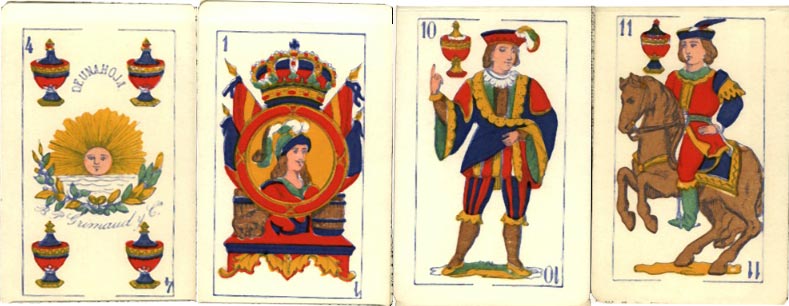
Above: Grimaud Spanish pattern, c.1880, one of many Spanish-suited styles imported from Europe.
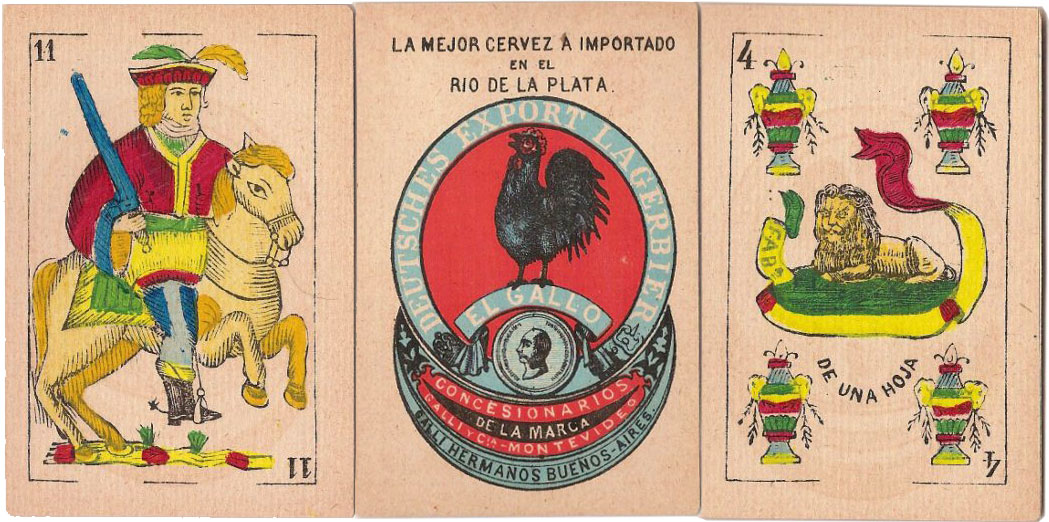
Above: advertising pack for Cerveza ‘El Gallo’ made in Belgium for Galli y Cia (Montevideo), c.1880, based on a Spanish model.
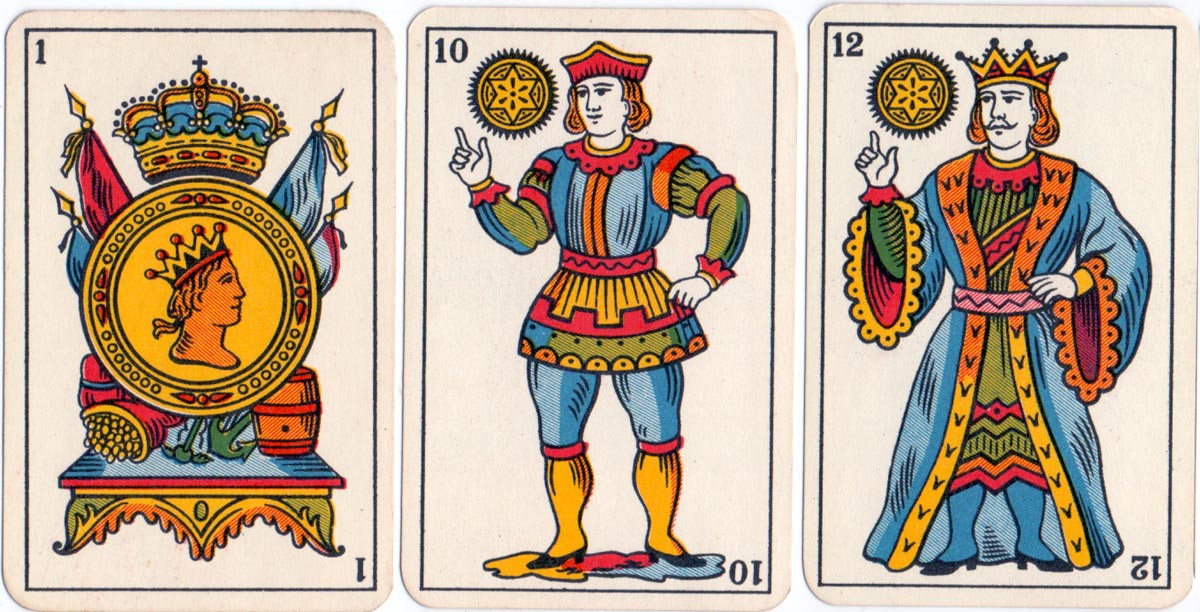
Above: Naipes 'Bambú' Spanish Catalan pattern made by M.C. de Casabó Ltda, Montevideo, early 1950s.

Above: Anglo-American-style Naipes ‘American’ manufactured by M.C. de Casabó Ltda, Montevideo, c.1950.


The 'Parisian' Spanish pattern became established in Uruguay based on examples imported from France. At some point (c.1960) Uruguayan manufacturers tried to 'modernise' the appearance of this pattern with new court designs based loosely on Fournier's 'Castilian' pattern. This 'New Uruguayan' pattern is still produced today. The Spanish 'Catalan' pattern also arrived, imported from Barcelona or Argentina. Some Anglo-American style packs have also been produced with interesting court card designs. Second only to Argentina, Uruguay has produced a number of Gaucho themed packs as well as a selection of novel designs and children's packs. More recently, since 1990, large quantities of playing cards are imported from Spain, USA, China and Brazil.

Above: Naipes Victoria Gaucho-themed pack manufactured by Compañia General de Fósforos Montevideana, S.A., c.1975. more →
REFERENCES
Silvera Antúnez, Marcos: Historia de los Naipes en el Uruguay 1724-2015, Ediciónes el Galeón, Montevideo, 2015

By Simon Wintle
Member since February 01, 1996
I am the founder of The World of Playing Cards (est. 1996), a website dedicated to the history, artistry and cultural significance of playing cards and tarot. Over the years I have researched various areas of the subject, acquired and traded collections and contributed as a committee member of the IPCS and graphics editor of The Playing-Card journal. Having lived in Chile, England, Wales, and now Spain, these experiences have shaped my work and passion for playing cards. Amongst my achievements is producing a limited-edition replica of a 17th-century English pack using woodblocks and stencils—a labour of love. Today, the World of Playing Cards is a global collaborative project, with my son Adam serving as the technical driving force behind its development. His innovative efforts have helped shape the site into the thriving hub it is today. You are warmly invited to become a contributor and share your enthusiasm.
Related Articles

Visite Mexico
Promoting Mexican tourism with 54 different photographs in full colour.

Catalan pattern by B.P Grimaud
Standard Spanish Catalan pattern deck made in Paris by B.P Grimaud.

Archaic Spanish proof sheets
2 x uncoloured proof sheets of archaic Spanish-suited playing cards produced for “New Spain”, possib...

Peintres Latino Americains
Original artwork by 18 different Latin American artists.

B.P. Grimaud pack for Bolivia
Spanish-suited pack made in France for sale in Bolivia, c.1880.

South American Costumes
Costumes of people of Brazil, Peru and Mexico, with views of Rio de Janeiro on the aces.

Félix Solesio e Hijos
Félix Solesio e Hijos - Real Fábrica de Madrid - Spanish National pattern for Venezuela

Parisian Spanish pattern by Fossorier, Amar et Cie
‘Parisian’ Spanish pattern published by Fossorier, Amar et Cie (Paris), c.1902.

Félix Solesio e Hijos
Félix Solesio e Hijos, Fábrica de Macharaviaya, Spanish National pattern for West Indies, 1801.

Naipe de Bridge
Standard English pattern pack made in Ecuador, c.1970.

Christopher Columbus 5th Centenary playing cards
Fifth Centenary of the Discovery of America playing cards by published by Heraclio Fournier.

Parisian style Spanish deck by Grimaud
Parisian style Spanish deck by Grimaud for export to Uruguay.

Naipes Criollos
“Naipes Criollos” Gaucho playing cards, 1995.

Anonymous Spanish Suited pack, c.1760
Anonymous archaic Spanish suited pack, c.1760.

America
“America” playing cards designed by Teodoro N Miciano, 1960.

Pedro Domecq
Anglo-American pattern for Pedro Domecq Mexican brandy made by Productos Leo S.A., c.2000.
Most Popular
Our top articles from the past 28 days





